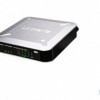Cisco RVS4000 User Guide - Page 27
VPN > IPSec VPN, Disconnect, Enable, IP + Domain Name FQDN Authentication, IP Only, Subnet, Address - vpn client setup
 |
UPC - 745883572977
View all Cisco RVS4000 manuals
Add to My Manuals
Save this manual to your list of manuals |
Page 27 highlights
Chapter 5 Setting Up and Configuring the Router Tunnel(s) Defined Displays the number of tunnels currently defined. This number will be greater than the Tunnels Enabled field if any defined tunnels have been disabled. VPN Clients Status No. Displays the user number from 1 to 5. Username. Displays the username of the VPN Client. Status Displays the connection status of the VPN Client. Start Time Displays the start time of the most recent VPN session for the specified VPN Client. End Time Displays the end time of a VPN session if the VPN Client has disconnected. Duration Displays the total connection time of the latest VPN session. Disconnect Check the Disconnect checkbox at the end of each row in the VPN Clients Table and click the Disconnect button to disconnect a VPN Client session. VPN > IPSec VPN The VPN > IPSec VPN screen is used to create and configure a Virtual Private Network (VPN) tunnel. VPN > IPSec VPN 4-Port Gigabit Security Router with VPN Select Tunnel Entry To create a new tunnel, select new. To configure an existing tunnel, select it from the dropdown menu. Delete Click this button to delete all settings for the selected tunnel. Summary Clicking this button shows the settings and status of all enabled tunnels. IPSec VPN Tunnel Check the Enable option to enable this tunnel. Tunnel Name Enter a name for this tunnel, such as "Anaheim Office". Local Group Setup Local Security Gateway Type This has two settings, IP Only and IP + Domain Name (FQDN) Authentication. •• IP Only If this is selected, the RVS4000's WAN IP address automatically appears in the IP Address field. •• IP + Domain Name (FQDN) Authentication This is the same as IP Only, but includes a domain name for greater security. Enter an arbitrary domain name in the Domain Name field. The Router's WAN IP address automatically appears in the IP Address field. Local Security Group Type Select the local LAN user(s) behind the router that can use this VPN tunnel. This may be a single IP address or Sub-network. Notice that the Local Security Group Type must match the other router's Remote Security Group Type. IP Address Enter the IP address on the local network. Subnet Mask If the Local Security Group Type is set to Subnet, enter the mask to determine the IP addresses on the local network. Remote Group Setup Remote Security Gateway Type Select either IP Only or IP + Domain Name (FQDN) Authentication. The setting should match the Local Security Gateway Type for the VPN device at the other end of the tunnel. •• IP Only Select this to specify the remote device that will have access to the tunnel. Then either select IP Address from the drop-down menu and enter the remote gateway's WAN IP address in the IP Address field, or select IP by DNS Resolved from the dropdown menu and enter the remote gateway's domain name in the Domain Name field. •• IP + Domain Name (FQDN) Authentication This is the same as IP Only but includes a domain name for greater security. Enter an arbitrary domain name in the Domain Name field. Then select either IP Address or IP by DNS Resolved from the drop-down menu, and fill in the IP Address field or Domain Name field. 20















